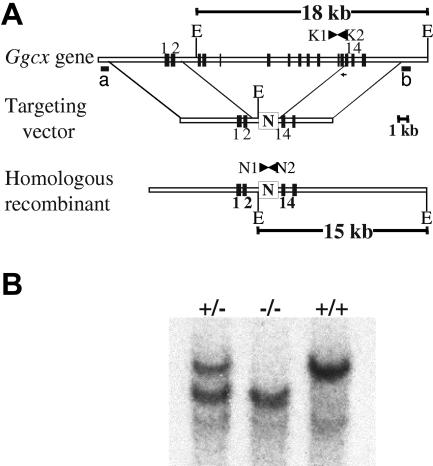Figure 1.
Targeting of the murine γ-carboxylase gene by homologous recombination. (A) structure of the endogenous γ-carboxylase gene. The targeting vector contains a neomycin resistance cassette (N), driven by the phosphoglycerokinase promoter, that replaces murine exons 3 to 13 flanked by 5.8 kb of 5′ and 7 kb of 3′ homologous DNA arms. The predicted product of successful homologous recombination is shown at the bottom. The location of hybridization probes a and b, used to detect successful targeting, are indicated. (B) Southern blot analyses demonstrating the expected genomic fragments from the 3′ end of the locus. Genomic DNA was prepared from tail biopsies of Ggcx+/+, Ggcx+/−, and Ggcx−/− mice and was analyzed by restriction digestion with EcoRV and hybridization with probe b. Restriction of Ggcx+/+ genomic DNA yields a fragment of 18 kb after hybridization with probe b. The targeted Ggcx+/− DNA yields 2 distinct bands of 15 kb and 18 kb, indicating that correct targeting of the Ggcx gene has occurred. Animals harboring copies of the targeted allele at both chromosomal loci show the expected hybridization band only at 15 kb, indicating that both copies of the Ggcx gene have been successfully deleted. The presence of the PCR primers (N1, N2, K1, and K2) used for subsequent genotyping are indicated in panel A.

